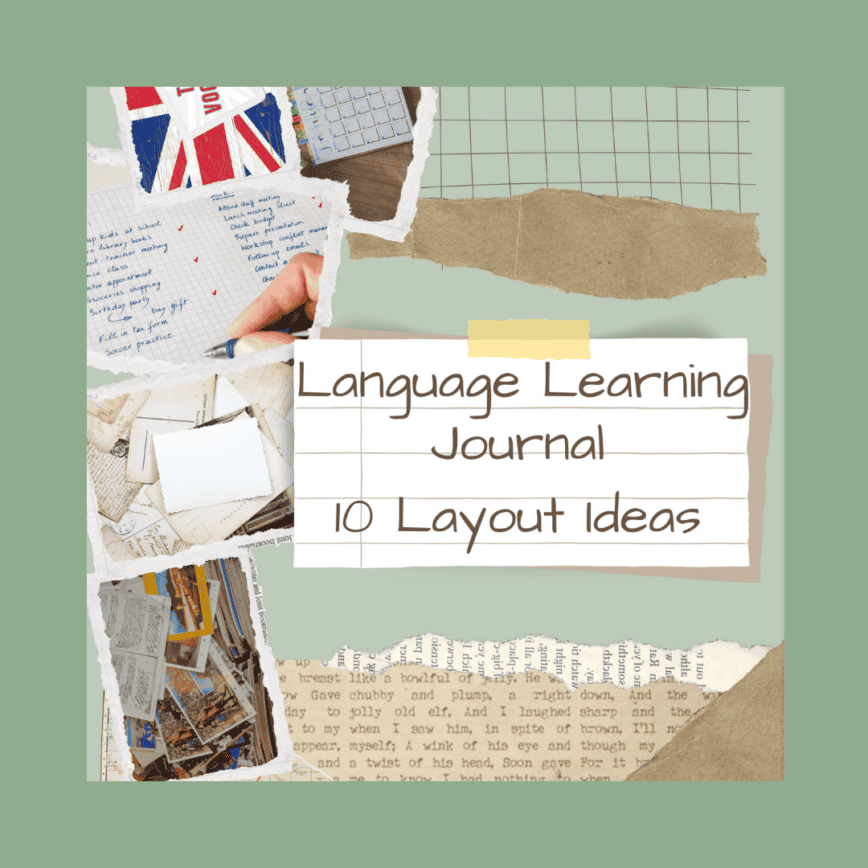
I am a huge fan of Charlotte Mason’s thinking towards language learning and of course nature and want to bring these ideas to you for your language learning notebooks!
These layout ideas are there for you to improvise and design for your own needs, and I will be posting out layouts on our Instagram stories (and of course adding them to our highlights).
We talked about a language learning notebook on the blog a couple of months ago, if you want to read it again here it is.
So now I want to talk to you about different layouts that you can create with a twist of Charlotte Mason and her language learning ‘principles’ so that your children enjoy learning languages.
These layouts are based on children between that ages of 4-11 years old. I talk predominantly about the English and German language but these ideas could be used for whatever language you are introducing.
1. Nature-Inspired Vocabulary Layout
Charlotte Mason always emphasised the importance of nature study. Create a vocabulary section based on the natural world.
- Design: Dedicate pages to different themes like animals, plants, and weather. Include columns for the English and German names, with space for illustrations or photographs of the objects.
- Activity: Encourage your children to find examples of these words during nature walks and add them to the notebook.
2. Language Journal Layout
The Charlotte Mason method includes daily journaling and narration.
- Design: Create a language journal with sections for daily entries. Include prompts for the child to narrate events or describe nature scenes in both English and German.
- Activity: Use this layout for regular narration exercises, encouraging children to draw (or write for older children) their experiences and then discuss them in both languages.
3. Illustrated Stories Layout
Living books and storytelling are key to the Charlotte Mason approach.
- Design: Dedicate pages for writing or retelling stories. Encourage children to illustrate the stories with drawings or cutouts. Include a section for a brief summary in English and German.This section can be adjusted to the childs relevant age group, for example for drawing and telling of a stroy rather than writing and just checking some words in the foreign language to ensure understanding and retention.
- Activity: Use favourite books as inspiration, and ask your child to retell or rewrite the story in their own words.
4. Sentence Building Layout
This layout focuses on building short easy to learn sentences.
- Design: Create a simple grid with sections for different parts of speech. Use colour-coding to differentiate nouns, verbs, adjectives, etc. Include examples and space for your child to create their own sentences in English and German. In Austria they are really into learning the grammar side from the start go, which is not so easy so having it colour coded helps immensely with understanding.
- Activity: Play sentence-building games, using word cards or magnets, and let your child record the sentences they create in the notebook.
5. Word Picture Layout
Combining words with images can help children remember vocabulary.
- Design: Dedicate pages to creating “word pictures.” Write a word in both languages and have your child draw or paste an image that represents it.
- Activity: Use magazines or printouts to find images, or encourage children to draw their own pictures to match the words.
6. Nature Diary Layout
Let’s bring in a connection to nature – you know I love this side of things!!!.
- Design: Create a nature diary section where your child can record observations from nature walks. Include sections for writing in English and German, with space for sketches or photos.
- Activity: Go on regular nature walks and ask your child to describe what they see, hear, and feel. Encourage them to use new vocabulary in both languages.
7. Phrasebook Layout
A simple layout for learning common phrases.
- Design: Create a section for common phrases used in everyday life. Divide the page into different contexts, such as greetings, questions, and polite expressions. Include the English phrase and its German equivalent.
- Activity: Practise these phrases in daily conversations. You can also create flashcards to help with retention and incorporate them into the notebook.
8. Cultural Exploration Layout
Charlotte Mason valued the understanding of culture and history.
- Design: Dedicate pages to exploring cultural aspects of English and German-speaking countries. Include information about traditions, holidays, or famous landmarks. Use images, cutouts, or drawings to illustrate these cultural elements.
- Activity: Research different cultural topics with your child, and let them add their findings to the notebook. Discuss the similarities and differences between the cultures. You could also add recipes to try out.
9. Review and Reflection Layout
A layout for tracking progress and reflecting on learning.
- Design: Create a simple checklist for reviewing vocabulary, grammar, and other key concepts. Include a section for reflection, where your child can write about what they’ve learned and what they enjoy most.
- Activity: Use this layout to set goals and review progress regularly. Encourage children to reflect on their language learning journey and suggest areas for improvement.
10. Interactive Activities Layout
Interactive learning aligns with the hands-on approach of Charlotte Mason.
- Design: Create a layout with interactive elements, like flaps, pockets, or pop-up sections. Include puzzles or games that relate to language learning.
- Activity: Add word searches, crosswords, or matching games to the layout. You can also create interactive flashcards that can be stored in pockets within the notebook.
I hope that these creative layout ideas will help you create a language learning notebook together with your child/children so that language learning becomes exciting and not a chore with lots of fun times in nature.
Have fun learning languages!


